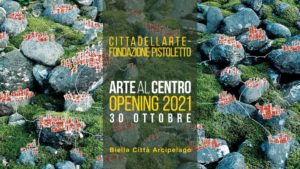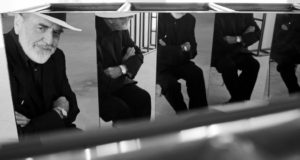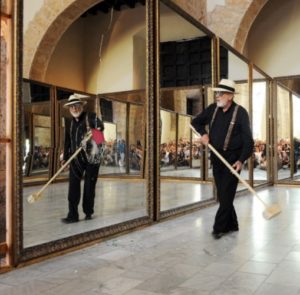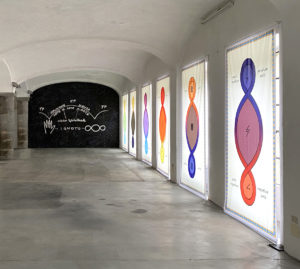Instants, blinks, tenths of seconds, fragments of finite in the infinity of the existence. In these almost imperceptible lapses of time, a mirror is able to reveal the naked truth to the observer, offering glimpses of a present that is constantly about to become the past. In Michelangelo Pistoletto’s Mirror Paintings, a glance is enough to engage a dualism between the spectator and the reflecting surface, the founding element of these works. In the wake of this process, we placed Arte al Centro in front of a mirror, in order to discover the new edition of the project through the voice of the Biellese artist. Michelangelo Pistoletto thus revealed what his artist eyes observed in this metaphoric mirror, in an intertwining of testimonies and reflections that leads to the discovery of the new edition of Cittadellarte’s annual event with a critical, introspective and perspective look.

During the health emergency, decrees were issued that led to closures and restrictions affecting museums and places of culture. This 23rd edition of Arte al Centro is the first to be organised after the outbreak of the pandemic. As regards to the artistic and social dimensions of the exhibition, what is the value of being able to participate in presence, to rely again on a face-to-face interaction between artist and visitor?
The impression I’ve had is of a second rebirth, because when I came out of the hospital after contracting COVID it felt as if I had been reborn. Back home, everything was at a standstill though. I continued to think and work anyway, in smart working as the rest of Cittadellarte, a modality that necessarily developed in an extraordinary way. The second rebirth consists in physically resuming activities, with direct contacts between people occurring no longer only in a virtual way. The lockdown experience has after all entered the collective DNA of the world. This edition of Arte al Centro has taken shape and has been articulated through a leap of conscience brought about by a condition of general involvement. In fact, the whole world has faced the same ordeal. This common experience has emphasised the concept of “art at the centre of a regeneration of society” and the responsibility of art in the very organisation of the social network that unites the human community. We don’t speak only of small, medium, separate communities anymore, as the word ‘community’ goes beyond this limited meaning and is equivalent to the word ‘society’ in its entirety. The lockdown has shown us that today globality exists as a general phenomenology on cultural, economic, health, political, scientific levels; it can no longer be understood only as part of a consumerist system. Even in light of this reality, Art at the Centre has a very specific meaning: not placing art “aside”, as a secondary element with respect to the socio-political-economic phenomenology, but as a primary phenomenon guiding every sector of society. It is no coincidence that in Cittadellarte we have Demopraxy as a point of reference, because we want ideals and practice to coincide. Our ideal is that of a harmonious world that must coincide with practice. The democracy implemented up to now is unfortunately unbalanced, and this leads to continuous violent oppositions and contrasts that prevent the practical fulfilment of the democratic dream. With the demopractic method, we are working to overcome this problem. Art at the centre of a change in society means that art, that is, the ability to create, must be disseminated to the point of making everyone authors of this renewal.

Among the novelties of this year’s Arte al Centro is the Universario, a space in Cittadellarte’s “column room” dedicated to the formula of trinamics and integrating the classrooms of Accademia Unidee. In this place reserved for education, can you outline what role creation, which you understand as a universal phenomenon, plays?
To identify creation as a universal phenomenon has been the goal of Cittadellarte since it was established and, even before, of my artistic research based on a personal need to find my identity. Through my Mirror Paintings, work tools for the entire Cittadellarte, I understood “who I am, where I am, why I am”, as they directly reflect me and everything that exists around me. The mirror cannot possibly exclude anything. It represents exactly the reality that lies in front of it. Everything that can be imagined is verified by its mirror image. If the imagination is wrong, the mirror sets the truth against it as it cannot lie. It speaks the truth regardless of our will. The game of reflection that exists between the mirror and reality corresponds to the process that occurs in our mind when we observe, in the Mirror Painting, the continuous exchange between the virtual and the real. For us human beings, the image is a primary element. Without it we would be pure instinct, while we are instead able to conceive what we see. Art and the Mirror Paintings share with the person the ability to see, think, reflect and calculate. The Mirror Painting is phenomenological, it is not a work that reproduces my emotions or my declarations, it represents a scientifically verifiable truth about things. Faced with this truth, I investigate the phenomenology of the existing and gradually identify the processes that make up the complexity of the universe. So passing from the Mirror Paintings to the Division and Multiplication of the Mirror, I came to define the formula of creation. This formula is based on the mathematical sign of infinity, consisting of a line that, crossing itself, forms two circles. The intersection of the line corresponds to the present, i.e. the image that, passing through the mirror, lasts only one instant. It was not there before, it’s there now and then it’s gone: infinity is therefore the present moment in the continuous transformation we and every part of the universe live in. In the present, everything is connected in an always new and always different perpetual conjunction. In the Universario, we see how this connection occurs and how it corresponds to the phenomenon of creation. To summarise: I crossed the line of the infinity sign twice thus creating a third circle between the two pre-existing ones. This central circle is where creation takes place. In it, in fact, all the elements contained in the opposite circles are joined together, continuously creating new elements that didn’t exist before. The Universario displays the “trinamic code”, which translates the phenomenology of creation into symbols.
What relationships and ties link the Universario to the embassies of the Third Paradise, engaged in disseminating the trinamic code?
The Rebirth/Third Paradise embassies are born from the vocation of people who have understood how to intervene in the world, participating in generating a healthy balance in society; they strongly feel the dramatic and tragic contrasts affecting the artificial world in which we live. This vocation leads to understanding and acting for the regeneration of thought and action in human society. It also leads to adopting the trinamic formula and to activating it, connecting the elements they have at hand to harmonise them and create a new state compared to the previous one. From this point of view, an example to mention in connection with the Universario is the school: there are many ambassadors who are professionals in the world of learning, especially early learning. Many of them have realised the importance of teaching children how to continuously connect elements, for example nature and artifice, or to carefully consider daily choices that can produce environmental consequences. Many young people already feel the responsibility to take action for a change, like Greta Thunberg, a person with a clear vocation to the Third Paradise. At Cittadellarte we explain to young people that this third stage is not achieved through mere “manifestations” of disapproval but with “manifested actions”, that is, by making real proposals. This is precisely what needs to be taught to the new generations: to make proposals using the method of connecting differences. Now, the schools that adopt the approach of the Third Paradise have the possibility to develop this ability, without forgetting that adults, like children, must assume the same social responsibility. And this happens with Accademia Unidee.

Biella Città Arcipelago (Archipelago City), a laboratory of participatory territorial planning, aims at carrying out a development project that declines the relationship between urban and rural in ways capable of generating sustainable prosperity, drawing inspiration from the historical characteristics of the Biella area. It is no coincidence that Arte al Centro is an integral part and one of the highlights of the programme of Città Arcipelago – Festival of Sustainable Creativity. How can these two keywords intertwine, finding a synthesis and a balance?
Biella has become “Città Arcipelago”. These two words are functional, because the phenomenon of creativity affects all the residents of this city, which no longer has a simple programmatic strategy like it could have had in the 1900s, when it was totally focused on urbanized industry. In that context, the urban centre attracted as many people as possible to the industrial area, depopulating the countryside which was also being totally industrialised. Today, starting from the trinamic concept, we must connect nature, represented by the countryside, with artifice, to create the new city. Cittadellarte teaches how to correlate these two elements: nature and artifice. Nature and artifice represent the two extremes of the Third Paradise: we create new perspectives by combining these two elements. To do this, we no longer have to remove nature from artifice, we must make them co-active instead, and in this co-activity economics and politics emerge, encompassing health, traffic, communication and above all energy. Today, in fact, we have a general connection in urban or interurban areas which is communication. The energy production system is fundamental. We need electricity also to be able to make use of the virtual network. So how can we solve the global energy problem? Not only through large global systems, often harmful to nature, but through local systems. The term ‘glocal’ remains very relevant, because you have to think about working on a local dimension to benefit the global one. With Città Arcipelago we are in fact aiming at a territorial recovery whilst taking on global critical issues. If we solve problems here in Biella, others will realise that they can also be solved elsewhere. If we take into account that Biella is in communication with the whole world, you see how we can become a proactive voice at global level.

We conclude by talking about the function that you think this event serves for the macro-cosmos of Cittadellarte. What process makes this initiative key to placing art at the centre of a responsible transformation of society? If you looked at Arte al Centro in the mirror, what would you see?
Art at the Centre looks at society in the mirror but not only in a contemplative way. We look at the world through the mirror of Cittadellarte to work on its regeneration. Having the Universario at the centre of Cittadellarte, where the concept of the universe is well definedand comprehensible even phenomenologically, we now know how the universe works. Not only that: our vision is connected to what has already been proven by science. The intuition that the scientific field has always had before obtaining practical verification exists in Cittadellarte as a phenomenon. But the very genesis of this phenomenon is exhibited in the permanent exhibition of my works on the upper floors of the same building. With the Universario, we bring the concept of the universe to students, citizens, children and in general to the whole of society; starting from the Universario, we disseminate understanding and assumption of responsibility. If one truly knows how the existing world works, they be come responsible for this knowledge.


